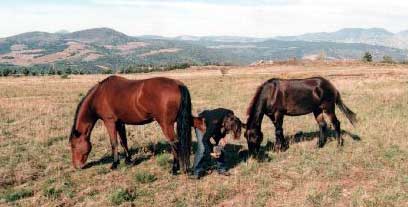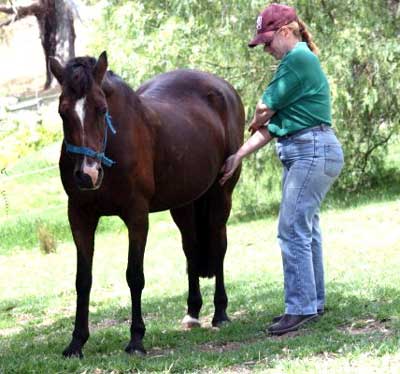How Rescue Horses Store Trauma
Guest Post By: Khaya Hanci Horse & Game Ranch, South Africa
Out here in the wide, open bushveld of South Africa, at Khaya Hanci, we offer rescued horses more than just a forever home; we offer them time, space, and quiet connection. Many of the horses who come to us have known pain: neglect, overwork, poor handling or even abuse. These experiences don’t vanish the moment they find safety. Instead, they linger, often hidden in the body.
A tight back, a stiff neck, flinching when touched, or eyes that never fully soften; these are more than behavioral issues. They’re silent messages, stored deep in the tissue. And it’s our job to listen.
Where Tension Comes From
As prey animals, horses are wired to respond to threats by tightening their muscles and preparing to flee. When trauma or stress overwhelms their system, and there’s no release, this tension stays locked in the body – sometimes for years.
Common causes include:
• Emotional trauma – such as fear-based training, separation anxiety, isolation or physical abuse. This often shows up in areas like the back, neck, jaw and shoulders.
• Poor saddle fit – A badly balanced saddle can pinch the spine and shoulder area, causing soreness, muscle bracing and behavioral resistance.
• Lack of movement – Horses need consistent, gentle movement to stay healthy. Stabled or underworked horses often develop stiffness, both mentally and physically.
• Emotional insecurity – An anxious horse holds its breath, clamps down the body, and stays on high alert. Over time, this becomes the new “normal.”
Trauma Shows Up in the Body
Horses are flight animals – their survival depends on being ready to move at any moment. When this system gets overwhelmed by stress or trauma, the body struggles to relax again. Tension builds, often in these key areas:
• Back muscles: Especially the longissimus dorsi, running along the spine, which carries the rider’s weight and takes a real beating when stressed.
• Neck muscles: Blockages here limit posture and breathing; traumatized horses often react sensitively around the poll.
• Shoulders and chest: Poorly fitting tack or harsh riding causes pressure, pain, and compensatory tension.
• Jaw and chewing muscles: These often hold silent emotional stress, horses stuck in their tension tend to have tight jaws and restricted chewing.
Three Simple Bodywork Techniques You Can Do at Home – Gentle. Mindful. Effective.
You don’t need to be a pro to support your horse. Often, calm hands, attentive observation, and a willingness to listen are all it takes. 
1. Long, Slow Stroking Along the Muscle Lines (5–10 minutes) Benefits: Calms the nervous system, loosens fascia, boosts circulation.
How to do it:
• Start at the base of the neck.
• Using your palm, stroke slowly and evenly over the neck, shoulder area, and gently along the back down to the croup.
• Follow the path of the longissimus dorsi – this key muscle supports the horse’s back and usually feels tight if they’re tense.
• Watch your horse closely: Are their eyes softening? Is the head lowering? Do they blink, chew, or even yawn? These are all signs they’re starting to relax.
Tip: Repeat each stroke 3–5 times per side, keeping your energy calm and steady. You can talk quietly or just be present, that’s enough.
2. Circular Massage on Tight Spots
Benefits: Releases trigger points, improves blood flow, helps muscles “let go”.
How to do it:
• While stroking, you might find firm, tense areas—often near the shoulder blades or where the back meets the croup.
• Place your fingertips or flat hand on the spot and gently make small circular motions – think “inviting” rather than “working hard”.
• Stay on one spot for 3–5 minutes and be patient – it can take time for your horse to release tension.
Look for signals: blinking, deep breaths, or skin twitching all mean progress.
3. Fascia Release Along the Flank
Benefits: Helps loosen the hindquarters, calms the nervous system.
How to do it:
• Run your hands along the flank, from the ribs down toward the loin.
• Alternate between broad, smooth strokes and light, rhythmic tapping, making sure your horse is comfortable.
• Horses with old saddle trauma or sacroiliac issues often relax noticeably here—sometimes even shifting weight onto a hind leg.
Mindfulness is Key
The most important part of bodywork isn’t the technique – it’s your attitude. Don’t approach it trying to “fix” anything. Be present, breathe calmly, and stay open. Horses can sense this immediately and will invite you into their relaxation process.
If you prefer to see some simple massage techniques in action, watch this video by Carmella Abel – Equine Helper.
Healing Begins with Touch
At Khaya Hanci, we see it every day: horses who once avoided contact start yawning, lowering their heads, or seeking you out simply because you listen without pressure.
Whether your horse is a rescue or not, every tension has a story. With gentle bodywork, respect, and patience, we can help them let go bit by bit. Sometimes all it takes is a quiet moment to feel: This is the start of trust. And maybe a new chapter.
Learn more about our work with rescue horses at: www.khayahanci.co.za
Learn how to help horses correct their own posture & feel amazing with Equine Hanna Somatics®




